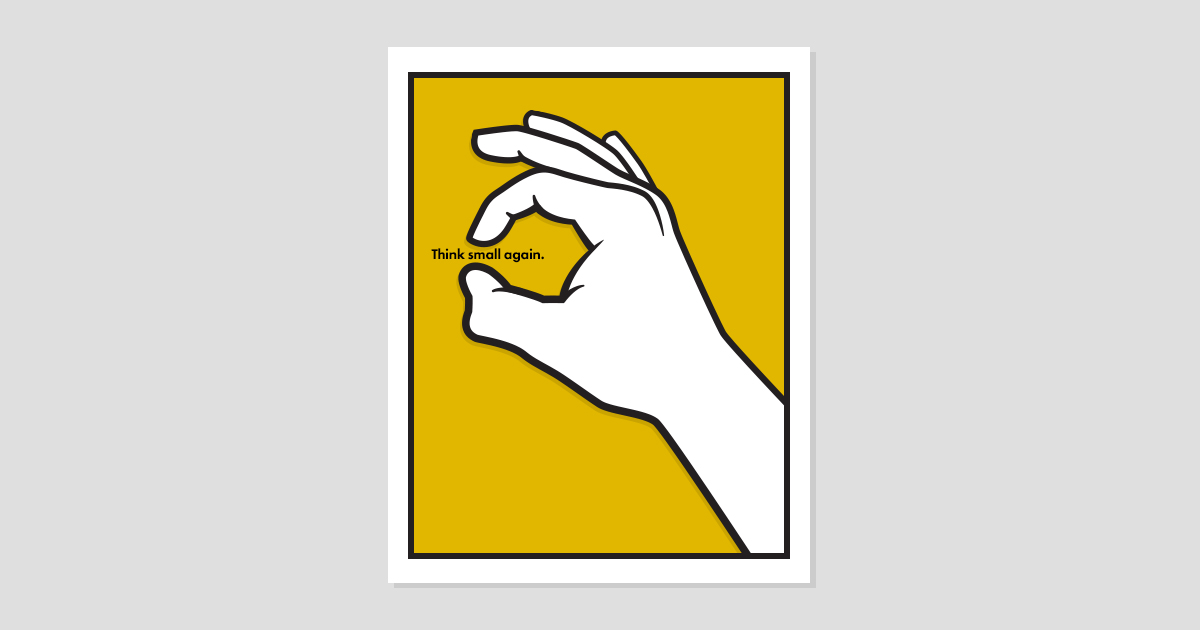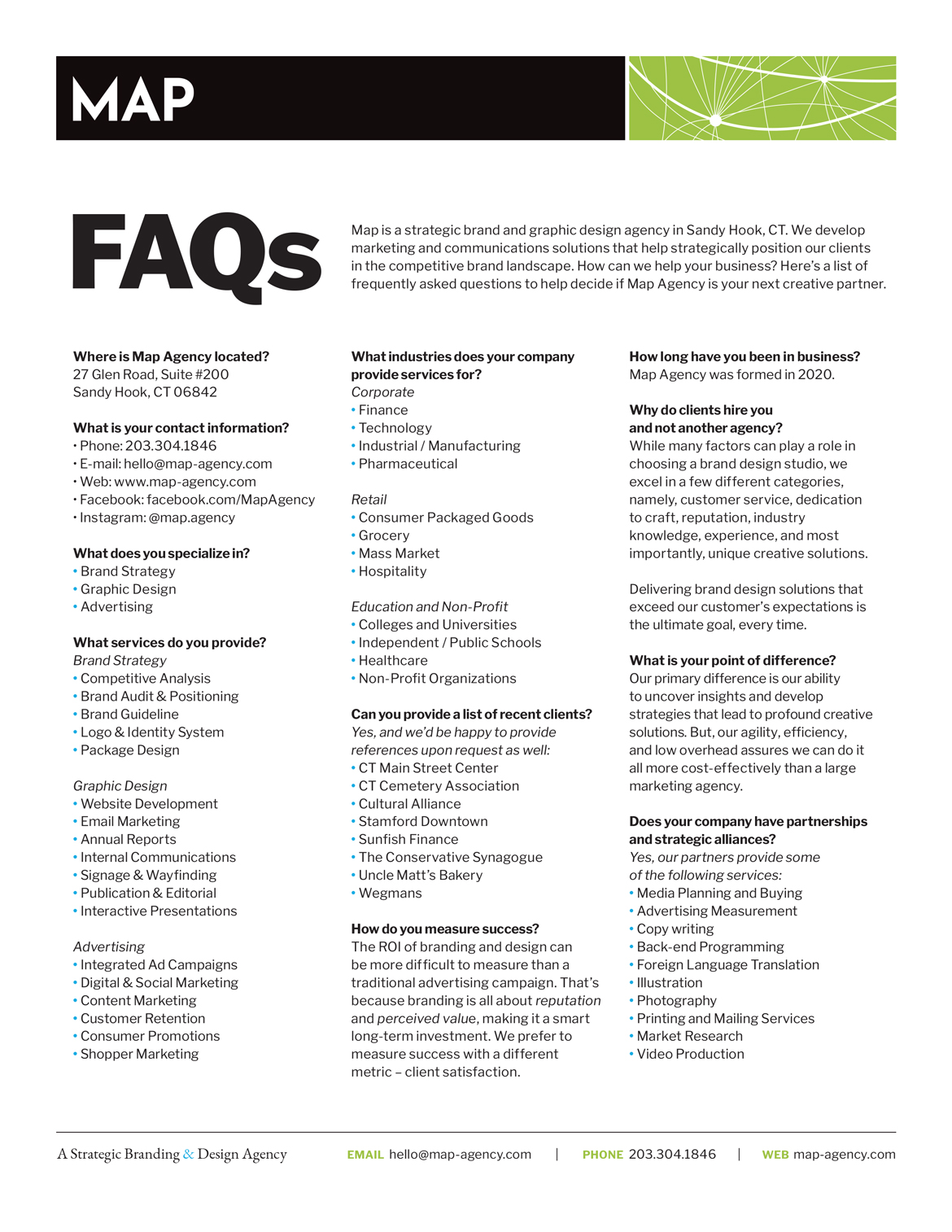The timeless “Think Small” Volkswagen ad, created in 1959 by Doyle Dane Bernbach, is embedded in most of our minds as the quintessential example of, ironically, the “Big Idea.” You know the one — the tiny silhouette of the VW Beetle, grounded by shadow but floating asymmetrically in a sea of negative space. The famous two-letter headline sits a mile below in Futura Heavy. The design works on multiple levels because it challenges perceived norms: both America’s propensity for gas-guzzling vehicles, and the reader’s graphic preconception of how a glossy print advertisement should look and act.
For those of us who went to school for Design, the ad was ubiquitous, being featured in both Megg’s History of Graphic Design (Page 353), and Hollis’ Graphic Design: A Concise History (Page 113). Held on such a pedestal, it’s no wonder so many of us have spent our careers crying, “Simplify!”
Understandably, the concept of going smaller was big in 2020. Smaller productions, smaller budgets, and, for many companies, smaller staff. For large agencies, reduction was somewhat expected, even if not immediate. In spite of that, 2021 has been an important year for small, independent agencies and studios, like ours, and — knock on wood —it appears that the number of opportunities will remain quite large.
Its been over 60 years since the VW ad first ran, but there has never been a better time for marketers, brand managers, and business leaders to once again consider the benefits of thinking small. This is not a call to simplify, or to rally ideas around the “Single-Minded Thought.” Instead, with so many innovative design opportunities tabled in the age of uncertainty, businesses can march ahead with an eye on the future of big ideas: the Small Agency.
No doubt, the Small Agency possesses a number of characteristics not only suitable, but preferable, for today’s competitive environment: cost, productivity, creativity, and, among the most important traits, agility.
Free from the constraints of multiple levels of hierarchy, the small studio acts nimbly. That doesn’t mean careful attention and consideration is brushed aside for creativity — quite the opposite, in fact. Team members at a small studio are themselves invested in the success of the business. While bureaucracy is successful at delegation, personal investment results in a roll-up-your-sleeves and get-it-done mentality. The ability to consider, learn, and adapt quickly provides clients with a direct advantage.
Externally, the marketplace shifts faster then ever before. Insights, opinions, and behaviors don’t just evolve; they trend, then rapidly change. Companies that adapt to these changes the quickest oftentimes reap the rewards, gaining the important advantage of being first-to-marketing, or obtaining the coveted early-adopters. Small, dedicated teams can be assembled quickly, ideas can flow, prototypes can be built, and changes can be made on the fly. Design Thinking, the Design Sprint, and the Lean Startup are all processes that work better with small, passionate teams that ignore groupthink.
Bonus: the teams at small agencies are built to be customer-oriented — an environmental by-product of problem-solving and collaboration. The empathic approach to design always considers the intended audience first. Likewise, creatives are able to partner with their clients’ and evolve in real time.
Another important benefit of working with a small agency, though often taboo, is cost. We all learned in 2020 that expensive overhead is unnecessary. Really smart, creative work can get done in just about any atmosphere — big, small, or remote. Small agencies don’t have big offices, and in many cases have moved to a completely remote model. That’s immediate savings that can be passed on to the client.
In addition, it’s likely that everybody at a small studio is involved in the projects their assigned from start to finish. That means clients don’t pay for staff that isn’t dedicated to their business. Side benefit: fewer managers means less red tape to cut through. Red tape has many negative connotations, deservedly so, but the biggest culprit is simple: it slows business down.
Furthermore, project-based work saves literally thousands of dollars compared to yearly retainer-based work. There are supplemental benefits to consider as well. Namely, project-based work keeps both the client and the studio invested in the task at hand. Authentic partnership almost always results in more unique, original, and meaningful work. When a certain level of trust is built in the relationship, a retainer can be outlined that is mutually beneficial.
By far, the most important factor to consider when choosing any creative agency is the quality of work. Exceptionally creative marketing communications that results in a return greater than the investment is the goal, every time. Which is why working with the most creative thinkers and designers is important.
It’s no secret that the smartest, most innovative thinkers — of which there are plenty — are always brought in to pitch new business at big agencies. It makes perfect sense to assemble a team that’s going to impress a potential new client. The reality is, once a business has been acquired, the team with the great ideas is almost never assigned to that client. When you hire a Small Agency, the people you hire are the people you work with. Their reputations are tied to the quality, craftsmanship, and professionalism they deliver – along with the success of their business. While a Small Agency won’t always have the ability to pitch work on speculation, any small business owner worth their salt is willing take the time talk about how they can contribute to help solve your design, marketing, and advertising challenges. It’s that partnership that always leads to smarter, more creative work anyway.
Undoubtedly, there is a place for creative agencies both large and small. For those who still question the Return on Investment for good design, consider the alternative cost of bad design. Look around, most things aren’t designed. Communication materials gets over-looked. Directions can be confusing or misleading. Brand and Product launches fail more often than not. But there is certainly no lack of talent — Incredibly smart people, many of whom we consider to be our friends, contribute to innovative creative solutions for their clients every day. Some work alone as freelancers, and other oversee teams of 50 or more. With the challenges that are present today, we think the opportunity is exceptionally big at the moment, for the small agency.

